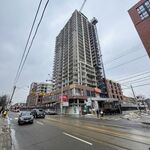A
AlvinofDiaspar
Guest
From the Star:
TTC shops for streetcars
Apr. 10, 2006. 01:00 AM
KEVIN MCGRAN
TRANSPORTATION REPORTER
Toronto is like no other city in the world. That's something for its citizens to be proud of. It's also something for the TTC's engineers to worry about.
The geography of the city poses unique challenges to Toronto Transit Commission officials who are trying to figure out how to replace the current fleet of streetcars with something more modern.
What they know today, coming into the Joint International Light Rail Conference in St. Louis, Mo., is that whatever Toronto and the TTC ultimately choose is going to be expensive — at least $1 billion to replace the current fleet.
Off-the-shelf streetcars — becoming ever so popular in places like Minneapolis, Houston and Portland — cost about $3 million each. But Toronto can't buy off the shelf in the manner of American cities that have seen an explosion in light rail. Those cities identified the kind of car they wanted and then built new systems to fit.
In Toronto's case, the infrastructure is old, so new cars have to be modified to fit — bumping up the cost by $1 million per streetcar.
"There's no light rail vehicle that can meet our requirements without some major modifications," said Stephen Lam, the TTC's superintendent of vehicle engineering, who is in St. Louis to size up the market. "It is a lot of money. Modification is going to be costly."
Off-the-shelf cars can't handle the sloping terrain of, for example, Bathurst St., so engine upgrades must be done. Such cars also can't handle the tight turns on city streets and streetcar loops, so the axles and trucks must be adjusted. The track gauge is also different, demanding another slight adjustment.
Lam said the best-case scenario is finding a car that can be modified to fit Toronto's system. But that's not as easy as throwing money at manufacturers.
"They will have to decide whether it's worth their while to come up with a business case, to come up with a design that suits our system."
The 248 streetcars on Toronto streets are close to 30 years old, the end of their useful life. They can be repaired, at a cost of $1 million to $1.25 million each, allowing the TTC to squeeze another 10 years out of them. Or the city could replace them and get 30 to 40 years out of the new stock.
"We love streetcars," said TTC chairman Howard Moscoe. "We're ready for the next generation. The ones we have are built like tanks. They're not accessible for the disabled, which is one of our goals — to make our system entirely accessible.
"They're heavy rail cars, very expensive to operate. They use more electricity than light rail. It's time we moved into the 21st century."
With the TTC feeling buoyed by a courtroom victory that will allow it to convert two lanes of traffic on St. Clair Ave. W. to a streetcar right-of-way, the push is on to replace rather than repair. New streetcar lines are inevitable as the road network expands.
"It's my goal to have streetcars running to the outer borders of Etobicoke, North York and Scarborough," Moscoe said.
AoD
TTC shops for streetcars
Apr. 10, 2006. 01:00 AM
KEVIN MCGRAN
TRANSPORTATION REPORTER
Toronto is like no other city in the world. That's something for its citizens to be proud of. It's also something for the TTC's engineers to worry about.
The geography of the city poses unique challenges to Toronto Transit Commission officials who are trying to figure out how to replace the current fleet of streetcars with something more modern.
What they know today, coming into the Joint International Light Rail Conference in St. Louis, Mo., is that whatever Toronto and the TTC ultimately choose is going to be expensive — at least $1 billion to replace the current fleet.
Off-the-shelf streetcars — becoming ever so popular in places like Minneapolis, Houston and Portland — cost about $3 million each. But Toronto can't buy off the shelf in the manner of American cities that have seen an explosion in light rail. Those cities identified the kind of car they wanted and then built new systems to fit.
In Toronto's case, the infrastructure is old, so new cars have to be modified to fit — bumping up the cost by $1 million per streetcar.
"There's no light rail vehicle that can meet our requirements without some major modifications," said Stephen Lam, the TTC's superintendent of vehicle engineering, who is in St. Louis to size up the market. "It is a lot of money. Modification is going to be costly."
Off-the-shelf cars can't handle the sloping terrain of, for example, Bathurst St., so engine upgrades must be done. Such cars also can't handle the tight turns on city streets and streetcar loops, so the axles and trucks must be adjusted. The track gauge is also different, demanding another slight adjustment.
Lam said the best-case scenario is finding a car that can be modified to fit Toronto's system. But that's not as easy as throwing money at manufacturers.
"They will have to decide whether it's worth their while to come up with a business case, to come up with a design that suits our system."
The 248 streetcars on Toronto streets are close to 30 years old, the end of their useful life. They can be repaired, at a cost of $1 million to $1.25 million each, allowing the TTC to squeeze another 10 years out of them. Or the city could replace them and get 30 to 40 years out of the new stock.
"We love streetcars," said TTC chairman Howard Moscoe. "We're ready for the next generation. The ones we have are built like tanks. They're not accessible for the disabled, which is one of our goals — to make our system entirely accessible.
"They're heavy rail cars, very expensive to operate. They use more electricity than light rail. It's time we moved into the 21st century."
With the TTC feeling buoyed by a courtroom victory that will allow it to convert two lanes of traffic on St. Clair Ave. W. to a streetcar right-of-way, the push is on to replace rather than repair. New streetcar lines are inevitable as the road network expands.
"It's my goal to have streetcars running to the outer borders of Etobicoke, North York and Scarborough," Moscoe said.
AoD
















